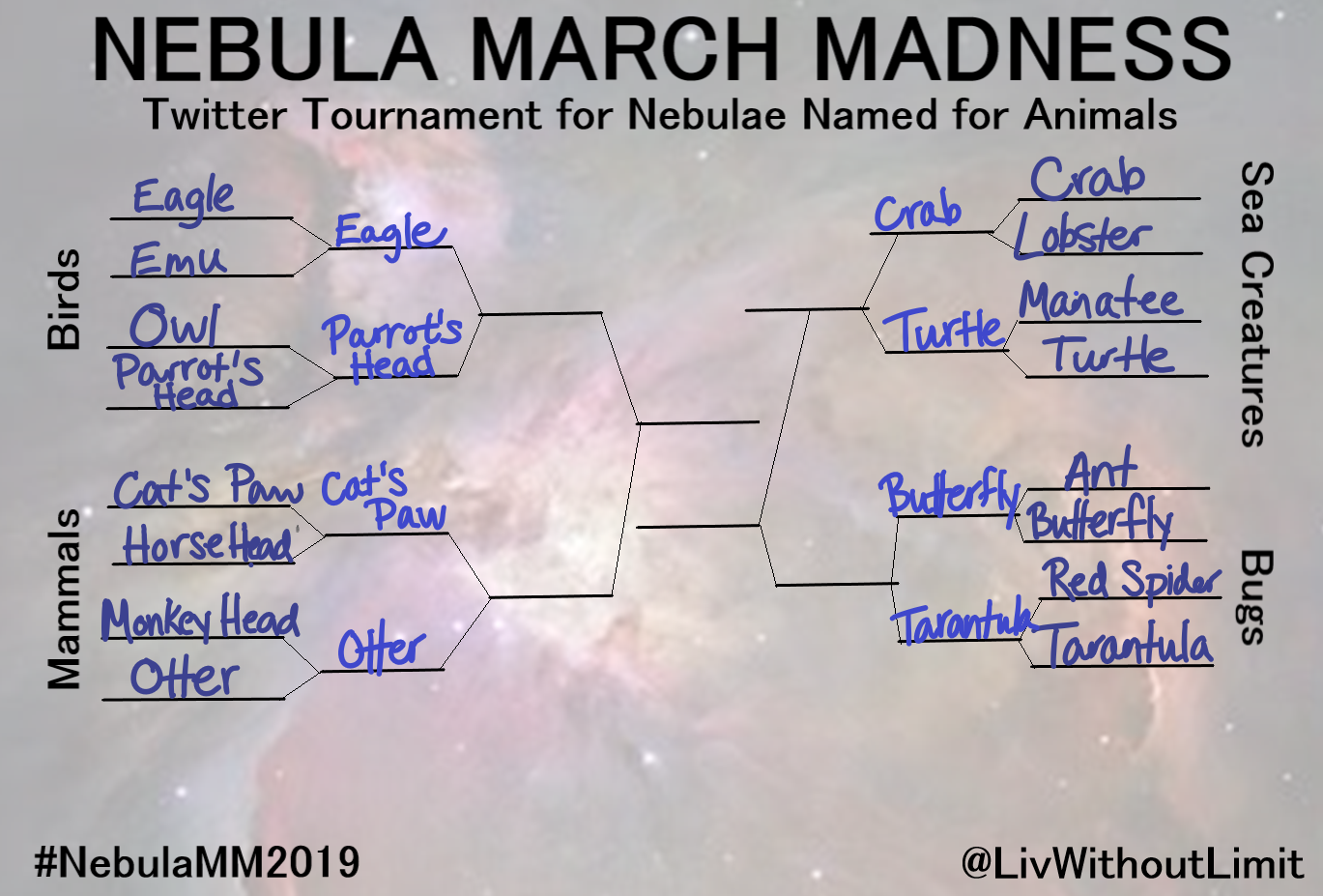Nebula March Madness 2019 - Round 2
Olivia Wilkins
Unfortunately, I edited this page instead of duplicating it to make the Round 3 bracket. That being said, I deleted half of the content and hit save before I realized my mistake, making it unable to be restored. I’ve recovered as much information as I could from my thread on Twitter, but it isn’t as complete as the original. *facepalm*
Round 2 was about “What’s it made of?” and we found that most of our nebulae in the bracket are HII regions—regions of ionized atomic hydrogen gas (H+), a marker of recent star formation. Across the different nebulae, there was a variety of the types of objects within, with star clusters, white dwarfs, or dust helping to give the nebulae their visible characteristics.
The division champs are:
Birds: Eagle (the Eagle Nebula and the Parrot’s Head Nebula tied, but this face-off ended on the birthday of an astrochemist and Eagle Nebula enthusiast, so happy birthday, Veronica! The Eagle Nebula is moving on!)
Mammals: Cat’s Paw
Sea creatures: Crab
Bugs: Butterfly
Who will move on to the final round? Stay tuned to find out!
What is a nebula?
A nebula is a cloud of gas and dust in outer space. Nebulae vary in size and composition and can have atomic, ionized, or even molecular gas. Some nebulae consist of molecular clouds which are sometimes affectionately called stellar nurseries (if they contain star-forming regions, that is!).
Nebulae are often named for what observers think they look like, and I've selected 16 nebulae that have been named for animals. I've divided these up into those named for birds, mammals, sea creatures, and bugs, and each week we will eliminate a handful of nebulae and learn a bit more about the rest.
ROUND 3: Discovery
This round focuses on the story behind the discovery of different nebulae. In this round, we might learn when and by whom a nebula was first observed or why it was given it name.
BIRDS: Eagle Nebula vs. Parrot’s Head Nebula
Eagle Nebula (Image: ESO)
Right ascension: 18h19m
Declination: -13°49’
Distance: 7,000 lightyears
Radius: ~70 x 55 lightyears
Constellation: Serpens
The Eagle Nebula, located in the constellation Serpens, is part of a diffuse emission nebula, or HII (“H-two”) region. An emission nebula is formed of partially ionized gas that emit light at various wavelengths. HII is ionized atomic hydrogen, or H⁺, and is present in regions where star formation has recently taken place. The Eagle Nebula is home an estimated 8100 stars that are mostly concentrated to the northwest of the famous “Pillars of Creation”. There are several other active star-forming regions of gas and dust located in the nebula as well.
The Parrot’s Head Nebula, often called the Seagull Nebula, is also an HII region that is actively forming stars in the constellation Monoceros. It is roughly circular and centered about the star HD 53367, but the emission region is often described to include the open clusters NGC 2335 and NGC 2343, along with neighboring dust clouds that help define its birdlike shape.
MAMMALS: Cat’s Paw Nebula vs. Otter Nebula
Cat’s Paw Nebula (Image: ESO)
Right ascension: 17h19m
Declination: -35°58’
Distance: 5,500 lightyears
Radius: 40 lightyears
Constellation: Scorpius
The Cat’s Paw Nebula is an emission nebula. It is an HII region thought to contain thousands of stars, but many of its stars are concealed by dust. The nebula’s glow is due to a host of hot young stars ten times as massive as the Sun; these stars burn very hot and very fast.
The Otter Nebula—-the unofficial name for NGC 604—is an HII region as well but one located outside the Milky Way in the Triangulum Galaxy. The nebula’s gas is ionized by a cluster of massive stars—around 200 O-type stars (the biggest, hottest, and bluest stars)—at its center.
SEA CREATURES: Crab Nebula vs. Turtle Nebula
Crab Nebula (Image: NASA/ESA)
Right ascension: 05h35m
Declination: +22°01’
Distance: 6,500 lightyears
Radius: 5.5 lightyears
Constellation: Taurus
The Crab Nebula is a supernova remnant in Taurus. The filaments in the nebula are remnants of the progenitor star, or the star that exploded at its center. These filaments are largely made up of ionized helium and hydrogen but also contain carbon, oxygen, nitrogen, iron, neon, and sulphur, all of which are made in the star.
The Turtle Nebula is a planetary nebula. This type of nebula is an expanding shell of ionized gas ejected from aging red giants. Despite the word “planetary” being in the name of this type of nebula, these nebulae have nothing to do with actual planets except that they are around stars, which most likely have at least one planet orbiting around them. The Turtle Nebula has hot gas jets streaming through an older shell of relatively cool gas. It spits out elements fused in the star’s core.
BUGS: Butterfly Nebula vs. Tarantula Nebula
Butterfly Nebula (Image: NASA/ESA)
Right ascension: 17h14m
Declination: -37°06’
Distance: 3,400 lightyears
Radius: >1.5 lightyears
Constellation: Scorpius
The Butterfly Nebula is a bipolar planetary nebula extending out from a white dwarf. The bipolar outflows may have been caused by a dense disk of gas and dust. In the nebula, there is evidence of carbonates, crystalline water ice, and quartz.
The Tarantula Nebula is an HII region in the Large Magellenic Cloud. A bright star cluster at its center makes it so bright that if it were as close as the Orion Nebula (about 1300 lightyears away instead of 160,000 lightyears) it would cast visible shadows on the Earth!
Which nebulae are your picks? Share in the comments, and don't forget to follow along on Twitter!
All information sourced from Wikipedia.
